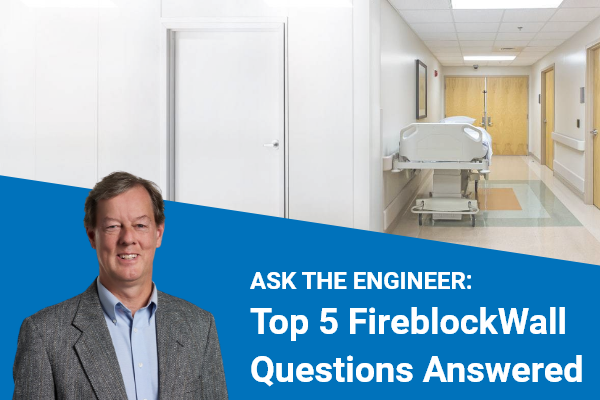
When we launched FireblockWall™ in 2021, customers were excited to finally have a reusable one-hour fire-rated temporary containment system. There was nothing else like it on the market, and it was something Project Managers, Contractors and Facilities Managers had requested since day one.
As the only safe and sustainable solution that can be used over and over again, the key advantages to using FireblockWall caught on quickly. Not only did it install four times faster than drywall, saving teams time and money, but it meets four industry fire codes, including the critical certification for a one-hour fire barrier. Plus, it satisfies ICRA Class IV and Class V guidelines.
As you might expect, the FireblockWall system drew a lot of attention for its versatility and safety features. It also raised some commonly asked questions among customers. In this blog post, we’re checking in with Bruce Bickford, Vice President of Product Development, for answers to your Top 5 questions about FireblockWall. Of course, if your question doesn’t appear below, we’d be happy to connect with you – but the following information should provide clarification.
Top 5 questions about FireblockWall
What are FireblockWall panels made of?
FireblockWall panels are built on a galvanized steel frame for extra durability, providing years of reuse. Our proprietary inner core provides a certified one-hour fire rating and superior noise-blocking with a Sound Transmission Class (STC) rating of 40. The powder-coated surface provides an attractive finish, which blends into existing environments. The surface is easy to clean and readily accepts vinyl graphics. FireblockWall panels come in two standard heights: 92” or 104”, which can accommodate 8’ to 10’ ceiling heights. When required, 6” or 12” extension panels can be added to larger panels to create additional height. When installed as specified, the panel design and gaskets create airtight seals that contain dangerous dust, debris and pathogens, which means they exceed ICRA Class IV guidelines.
What’s the main difference between FireblockWall panels and STARC’s other panels?
The main difference is the method of construction. With RealWall™ and LiteBarrier™, the method of construction is frame and panel; for FireblockWall, it’s skin and core. In addition, RealWall and LiteBarrier feature a foam core. FireblockWall’s core features a proprietary mix of materials.
Are STARC Systems’ panels fire-rated?
RealWall and LiteBarrier have an ASTM E84 Class A rating but are not fire-rated. FireblockWall is the first and only temporary, reusable containment that is one-hour fire-rated.
Is FireblockWall compatible with the other STARC panels?
Once a FireblockWall is installed, it can be treated as any other permanent wall in the building, so it is 100% compatible with our RealWall and LiteBarrier systems. Simply install FireblockWall first, then use the RealWall or LiteBarrier interface modules to fit up against the FireblockWall surfaces.
Is there a one-hour fire-rated ceiling available for the FireblockWall system?
Yes! FireblockCap™ was developed in response to feedback from early adopters of FireblockWall, who wanted a fast-and-easy ceiling option for creating a fully fire-rated enclosure. FireblockCap is a game-changer in the fire protection world of NFPA 101, enabling full compliance with building and fire codes for creating a one-hour rated assembly quickly and cost-effectively without disrupting traditional construction activities. Projects will be able to phase much more quickly with this new capability while meeting the recently updated ICRA 2.0 standards to the letter.
For a closer look at FireblockWall in action, check out this case study that details how S+B James Construction implemented our one-hour fire-rated temporary barriers on a particularly challenging job.
We hope this post addresses your questions about FireblockWall. If not, please reach out, and we'll get you the information you need.
Next month, Ask the Engineer will share the Top 5 questions we receive about our hinged, sliding, and double-door options.
Interested in More Information on STARC Systems?
